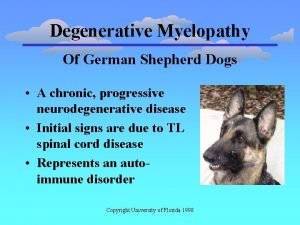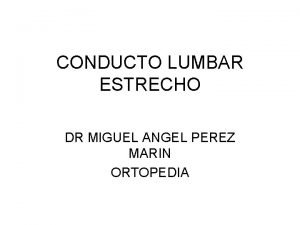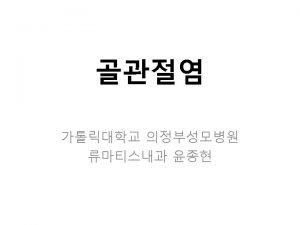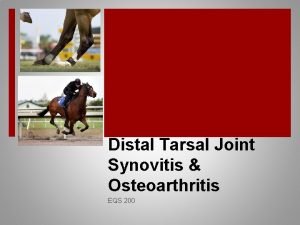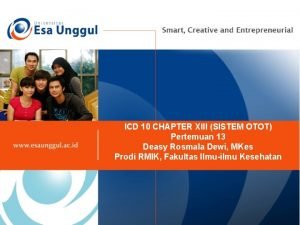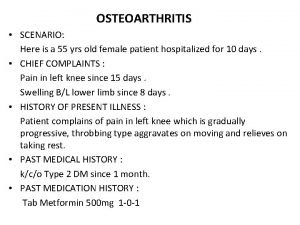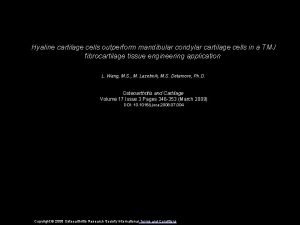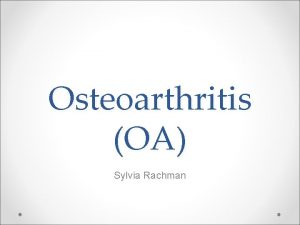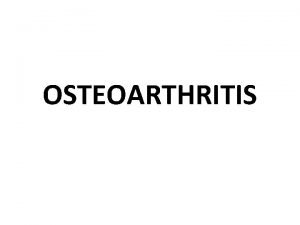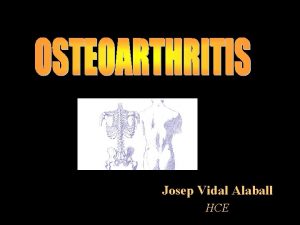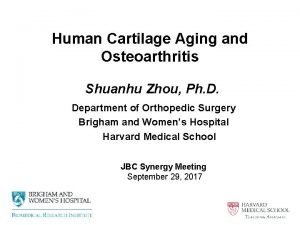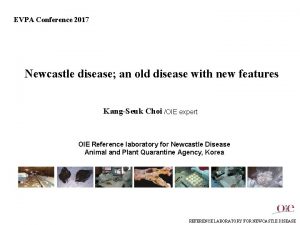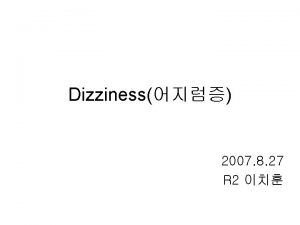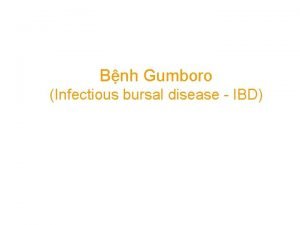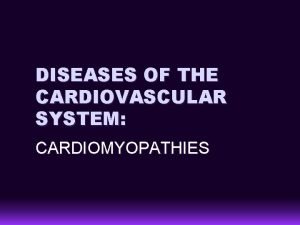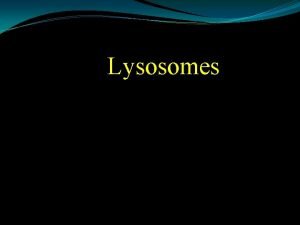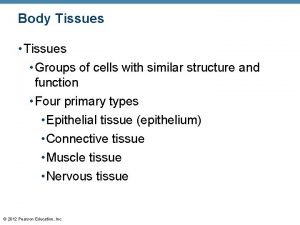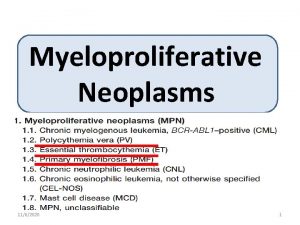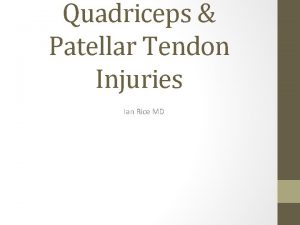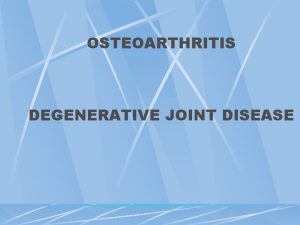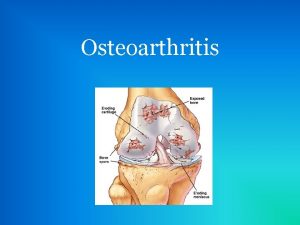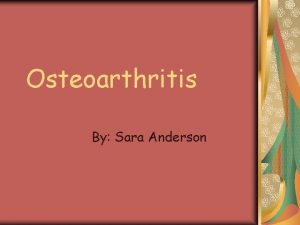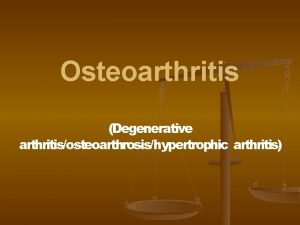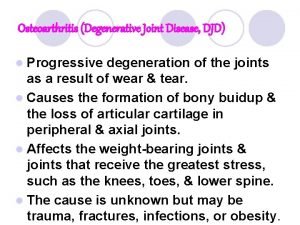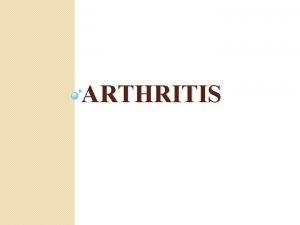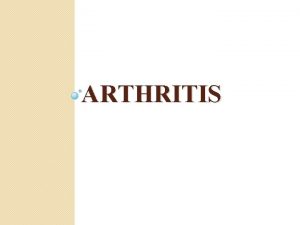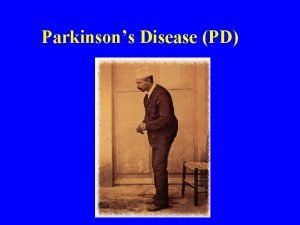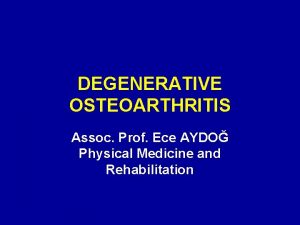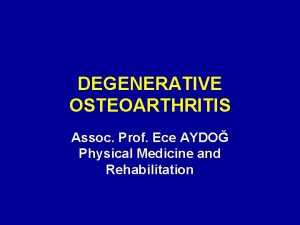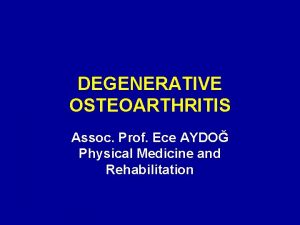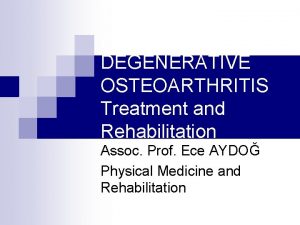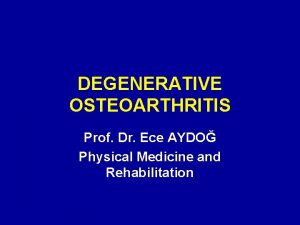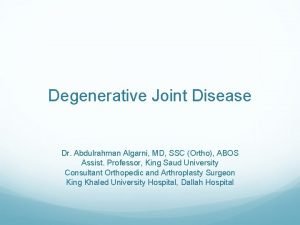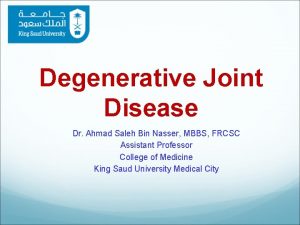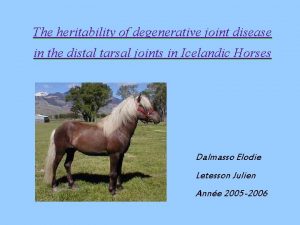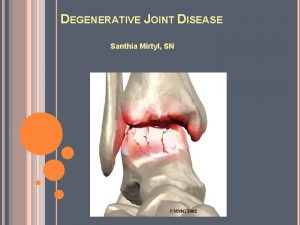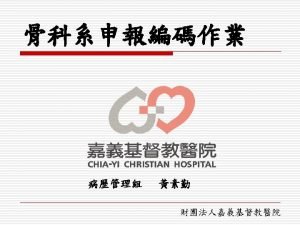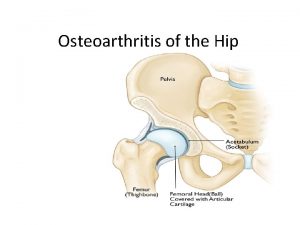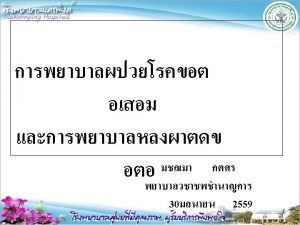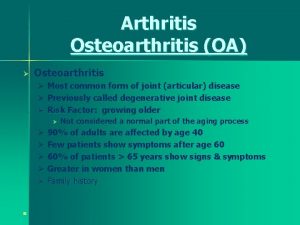OSTEOARTHRITIS Osteoarthritis is a degenerative joint disease that









![Changes in O. A • Calcium crystals (e. g. , calcium pyrophosphate dihydrate [CPPD], Changes in O. A • Calcium crystals (e. g. , calcium pyrophosphate dihydrate [CPPD],](https://slidetodoc.com/presentation_image_h/257df8bd145598673027fe2fdd193b24/image-10.jpg)





























- Slides: 39

OSTEOARTHRITIS

• Osteoarthritis is a degenerative joint disease that occurs primarily in older individuals and is characterized by erosion of the articular cartilage, hypertrophy of bone at the margins (i. e. , osteophytes), subchondral sclerosis, and a range of biochemical and morphologic alterations of the synovial membrane and joint capsule. • Osteoarthritis may be classified as primary or secondary according to its cause or major predisposing factor; both types have in common altered cartilage physiology.

• Primary osteoarthritis is the most common type and has no identifiable etiology or predisposing cause. • Secondary osteoarthritis, although it has an identifiable underlying cause, is pathologically indistinguishable from primary osteoarthritis. • The most common causes of secondary osteoarthritis are metabolic conditions.

ETIOLOGIC FACTORS IN OSTEOARTHRITIS • Major factors that affect the degree of risk for developing osteoarthritis include age, joint location, obesity, genetic predisposition, joint malalignment, trauma, and gender. • AGE • Age is the risk factor most strongly correlated with osteoarthritis. Osteoarthritis is the most common chronic disease that develops in later life. More than 80% of individuals older than 75 years are affected, and osteoarthritis increases progressively with age at all joint sites.

• Radiologic changes of osteoarthritis increase as individuals age, although these changes do not always correlate with clinical symptoms or disability. Although an age-related disease, osteoarthritis is not an inevitable consequence of aging.

JOINT LOCATION • Although osteoarthritis occurs most commonly in weight-bearing joints , age affects joints differentially. A study comparing tensile fracture stress of cartilage in the femoral head and in the talus showed that it decreased progressively with age in the former, but not in the latter. • Joint-specific, age-related viability in articular cartilage may explain why osteoarthritis is more common in hip and knee joints with increasing age, but occurs rarely in the ankle.

OBESITY • Obesity is another important risk factor for osteoarthritis. Greater body mass index in women and men has been shown to be associated with an increased risk of knee, but not hip, osteoarthritis. • obesity significantly increased the risk of knee symptoms and radiographic osteophytes.

JOINT MALALIGNMENT AND TRAUMA • Joint malalignment or trauma may lead to rapid development of osteoarthritis, or it may initiate a slow process that results in symptomatic osteoarthritis years later. • Probably as a result of progressive reduction in periarticular blood flow and the resultant decrease in rate of remodeling at the osteochondral junction, joints become increasingly congruent with age.

GENDER • Women are about twice as likely as men to develop osteoarthritis. Although women have a lower prevalence of osteoarthritis than men before age 50 years, there is a marked increase in prevalence among women after age 50, particularly in the knee.
![Changes in O A Calcium crystals e g calcium pyrophosphate dihydrate CPPD Changes in O. A • Calcium crystals (e. g. , calcium pyrophosphate dihydrate [CPPD],](https://slidetodoc.com/presentation_image_h/257df8bd145598673027fe2fdd193b24/image-10.jpg)
Changes in O. A • Calcium crystals (e. g. , calcium pyrophosphate dihydrate [CPPD], basic calcium phosphate crystals) are commonly found in the cartilage of the elderly, and often crystal arthropathy coexists with osteoarthritis. • It is unclear, however, whether these crystals are directly involved in the pathogenesis of osteoarthritis or are merely a by-product or marker of the disease. • calcium crystals play a role in causing or worsening osteoarthritis is supported by clinical and laboratory studies, but the relationship is complex.

• In osteoarthritis, the expression and production of proteinases is increased. Native collagen has been shown to be cleaved by Metaloprotienase(MMP); the resultant fragments may be susceptible to cleavage by other enzymes such gelatinase A, gelatinase B, stromelysin 1, and cathepsin B. • MMP-13 may be the most important in osteoarthritis because it preferentially degrades type II collagen. It also has been shown that expression of MMP-13 greatly increases in osteoarthritis . Overall, collagenase activity also markedly increases & it is a major factor in osteoarthritis progression and cartilage matrix degradation.

• • • Radiographic–pathologic correlates in osteoarthritis Pathological change Radiographic abnormality Cartilage fibrillation, erosion Decrease in interosseous. distance (localized). Subchondral new bone formation Sclerosis. New cartilage formation and endochondral ossification Osteophyte. Fibrous-walled pseudocysts resulting from fluid intrusion or myxoid degeneration Subchondral cysts. Trabecular compression Bone collapse. Fragmentation of osteochondral surface; cartilage and bone metaphasia in synovium Osseo('loose')bodies.

Osteophyte formation • Osteophytes—bony proliferations at the joint margins and in the floor of cartilage lesions—are partly responsible for the pain and restriction of joint movement in osteoarthritis. • In osteoarthritic joint osteophytes synthesize cartilage with significant amounts of type I collagen and nonaggregating proteoglycans. • Because osteophytes may increase joint surface available for load bearing, they may contribute to some cases of regression of the early osteoarthritis cartilage changes.

osteophytes may occur as a result of penetration of blood vessels into the basal layers of degenerating cartilage, or as a result of abnormal healing of stress fractures in the subchondral trabeculae near the joint margins. • osteophyte formation begins in the marginal zone, where synovium merges with periosteum and articular cartilage • TGF-β is a known anabolic growth factor that increases the expression of several types of collagen and proteoglycans. • TGF-β induces osteophyte formation, and TGF-β expression is observed in osteophytes in patients with osteoarthritis. •

• Bony proliferation may result from venous congestion. In human hip osteoarthritis, phlebography has shown the formation of medullary varices, presumably resulting from changes in the medullary sinusoids, which may be compressed by subchondral cysts and thickened subchondral trabeculae. • Subchondral cysts in osteoarthritis may be created by entry of synovial fluid under pressure through defects in the cartilage or may develop in necrotic areas of subchondral bone

• The increased venous pressure caused by the cysts and remodeled trabeculae may account for some of the pain in osteoarthritis. • Immobilization and glucocorticoids (but not bisphonates) have been shown to decrease the size and prevalence of osteophytes in experimental models of osteoarthritis.

RESPONSE OF CARTILAGE TO MECHANICAL INJURY • The response of normal articular cartilage to injury typically results in suboptimal repair; these injuries often can result in secondary osteoarthritis. • In contrast to tissues that have the ability to regenerate injured regions with new cells and extracellular matrices that closely resemble the original tissue, articular cartilage produces a repair tissue with neither the original structure nor properties of normal cartilage. • Chondrocytes in areas surrounding an injured zone are unable to migrate, proliferate, repopulate, or regenerate repair tissue with similar structure, function, and biomechanical properties of normal hyaline cartilage.

• That articular cartilage lacks regenerative power has a long history of documentation. The articular cartilage wounds healed with fibrous tissue, which he believed arose from chondrocyte intercellular substance. • So its proposed that cartilage repair is effected by fibrous tissue resulting from proliferation of cells from bone marrow, synovial membrane, and occasionally surrounding articular cartilage. It was later observed that the fibrous tissue subsequently transforms into fibrocartilage, with occasional foci of imperfect hyaline cartilage.

• The common findings was that articular cartilage lacks regenerative potential, and that the regenerative fibrous tissue and fibrocartilage tissue must have originated from undifferentiated mesenchymal tissue arising from bone marrow, synovium, or the superficial layer of articular cartilage. • Microdamage to the chondrocytes or extracellular matrix or both without gross disruption of the articular surface can be caused by a single severe impact or repetitive blunt trauma. • Repetitive loading of cartilage produces a surface loss of proteoglycans and an increase in chondrocyte metabolic activity

• Proteoglycans become more easily extractable from the articular cartilage, with a greater percentage of nonaggregated forms. • so its observed that cellular, metabolic, and biochemical changes after repetitive blunt trauma resemble the changes in the early stages of osteoarthritis—increased hydration, cellular degeneration or death, disruption of the collagen ultrastructure resulting in marked variation in the size and arrangements of fibers, fissuring and ulceration of the articular surface, thickening of the subchondral bone, and softening of the cartilage with loss of its compressive and tensile stiffness.

• Trauma induces the release of degradative enzymes and proinflammatory factors (e. g. , nitric oxide, TNF, IL-1) that frequently cause degradation of the surrounding matrix. • Eventually, the material properties of the cartilage are altered—cartilage matrix thins and subchondral bone stiffens—which often accelerate the degenerative process. • The point at which accumulated microdamage becomes irreversible is unknown, although it has been shown that lost proteoglycans and matrix components may be restored if damage to chondrocytes and the collagen network is limited, and the repetitive trauma is halted.

ROLE OF INFLAMMATORY MEDIATORS IN DISEASE PROGRESSION • Cytokines and Chemokines • A characteristic feature of established osteoarthritis is the increased production of proinflammatory cytokines, such as IL-1β and TNF-α, by articular chondrocytes. • IL-1β and TNF-α exert comparable catabolic effects on chondrocyte metabolism, decreasing proteoglycan collagen synthesis and increasing aggrecan release via the induction of degradative proteases. IL-1β and TNF-α also induce chondrocytes and synovial cells to produce other inflammatory mediators, such as IL-8, IL-6, nitric oxide, and prostaglandin E 2. • The actions of both cytokines are mediated partly by the activation of the transcription factor nuclear factor κB, which increases further their own expression and that of other catabolic proteins, such as inducible nitric oxide synthase (i. NOS) and cyclooxygenase-2 (COX-2), creating an autocatalytic cascade that promotes self-destruction of articular cartilage .

• IL-1β and TNF-α are synthesized intracellularly as precursors, converted through proteolytic cleavage to their mature forms by caspases—membrane-bound IL 1β-converting enzyme (ICE) and TNF-α-converting enzyme (TACE)—and released extracellularly in their active forms. • The expression of ICE and TACE has been shown to be upregulated in osteoarthritis cartilage. • Inhibitors of ICE and TACE are of interest as future therapeutic small-molecule antagonists of downstream IL-1β and TNF-α expression; studies with an ICE inhibitor are now under way in two murine models.

CLINICAL MANIFESTATIONS • Pain is the first and predominant symptom of osteoarthritis that sends a patient to the general practitioner. Pain typically is worsened by activities such as long distance walking for weightbearing joints and is alleviated by rest, in contrast to inflammatory disorders. • Pain begins within a few minutes of starting an activity and may persist for hours after the activity has ceased. • The pain sometimes can have an onset several hours after physical activities, especially in young patients. Although osteoarthritis pain is unusual during the night or at rest

• there are exceptions, including patients with mild osteoarthritis using joints for several hours especially during sport, in advanced osteoarthritis with destructive arthropathy, and in an acute inflammatory flare of osteoarthritis mimicking inflammatory arthropathy. • Associated bursitis also can be a source of pain. Pain intensity and joint damage on radiographs are poorly correlated. Finally, there is no agreement as to whether a decrease in atmospheric pressure or a change in the weather increases osteoarthritis pain.

• Although pain is the chief complaint its origin is not always clear. Hyaline cartilage is aneural and this means that metabolic or structural alteration in this tissue is unlikely to be directly perceived as painful. • Several other mechanisms of symptom production have been suggested ; • ♦ stimulation of capsular pain fibres and mechanoreceptors by raised intra-articular pressure due to synovial hypertrophy, increased fluid production, and decreased joint compliance; • ♦ inflammatory mediators stimulating pain fibres in the synovium and capsule; • ♦ stimulation of periosteal nerve fibres by intraosseous hypertension accompanying osteoarthritis;

• ♦ perception of subchondral microfractures; • ♦ painful periarticular structures such as entheses and bursae possibly resulting from abnormal biomechanics and/or muscle weakness; • ♦ adaptive changes in the spinal cord (central sensitization, 'wind-up') and brain (disinhibition, impairment of the Diffuse Noxious Inhibitory Control system) leading to persistent pain perception • Neovasculirisation of cartilage with innervation by unmyelinated nerve fibers.

• Stiffness and Loss of Movement and Function • Stiffness also may occur in the morning, after a period of inactivity, or particularly in the evening. Morning stiffness generally resolves after less than 10 minutes, in contrast to the prolonged (usually >30 minutes) stiffness seen in inflammatory disorders. • Loss of movement and function reflected in limited range of motion observed at physical examination is sometimes the main reason for a visit to the practitioner. • Patients report limitations in their ability to perform dayto-day activities, such as kneeling for knee osteoarthritis, or cutting one's toenails for hip osteoarthritis

• Limited joint function is caused by several mechanisms, including pain, decreased motion related to reduced joint space, diminished muscle strength, and instability. Joint proprioceptor sensitivity may be altered; its relationship to disability is less clear as yet, but is probably not caused by pain alone. • Lastly, symptomatic osteoarthritis may be associated with depression and disturbed sleep, which are additional contributors to disability. • Osteoarthritis, wherever it occurs, typically causes pain, alters function, and leads to a significant deterioration in the quality of life.

PHYSICAL EXAMINATION • physical examination should be done to confirm and characterize joint involvement and to exclude pain and functional syndromes arising from other causes, especially periarticluar structures and inflammatory arthritis. A normal examination does not rule out the diagnosis of osteoarthritis, however, especially disease of early nature or of modest severity. • Bony swelling is easily recognized in superficial joints, such as the finger joints or knees. A synovial effusion may be seen during osteoarthritis flares, but also can occur during chronic phases as a persistent feature.

• Joints are usually tender during active motion testing and under pressure. Limited passive movement can be the first and only physical sign of symptomatic osteoarthritis. • Bursitis, tendinitis, muscle spasm, and, especially for the knee, a torn meniscus, can cause the same pain syndrome and must be sought carefully during examination. • Crepitus, an audible or palpable sensation of crunching or crackling, is commonly felt on passive or active mobilization of an osteoarthritis joint.

• This sensation is due to the irregularity of the opposing cartilage surfaces or intra-articular debris. • Joint deformities reflect advanced disease with joint destruction involving the cartilage and surrounding bone and soft tissue, the articular capsule, and the ligaments. • the presence of Heberden's or Bouchard's nodes in the fingers in nodal O. A

Investigation • 1 -Standard radiographs are the most common investigations, depending on the region involved. Weightbearing radiographs are mandatory for knee and hip osteoarthritis. A standard radiograph cannot diagnose early osteoarthritis, however. The radiologic features of osteoarthritis are . • Osteophytes at the joint margin, indicating new bone formation, are the most characteristic feature of osteoarthritis and usually precede joint space narrowing. • Subchondral bone sclerosis and joint space narrowing are classically seen in more advanced osteoarthritis. Clinical symptoms and radiographic findings are poorly correlated,

• These are the radiologic features of the most common form of osteoarthritis—“hypertrophic” osteoarthritis with bone construction. The other form, “atrophic” osteoarthritis, is rare, characterized by an absence of osteophytes and sclerosis; it usually involves the hip. • 2 -The erythrocyte sedimentation rate and concentration of the C-reactive protein are usually within the normal range for age. Low titers of rheumatoid factors can be found, reflecting the median age of patients

MANAGEMENT • • • • Non-pharmacolgic Management of Osteoarthritis Conventional Options Patient education Arthritis self-help courses Weight loss Temperature modalities Exercise Orthotics Modified activities of daily living Unconventional Options Trans-cutaneous electrical nerve stimulation Pulsed electromagnetic fields Static magnets Acupuncture Yoga

• Exercise • Both the dynamic and isometric exercise showed equivalent improvement in symptoms and physical functioning. • Walking can be beneficial, and supervised fitnesswalking regimens can improve function in those with OA of the knee. • Home-based exercise interventions also significantly improve symptoms in those with knee OA.

PHARMACOLOGIC INTERVENTIONS • • • • Symptom-Relieving Pharmacologic Therapies for Osteoarthritis Topical Capsaicin Topical non-steroidal anti-inflammatory drug (NSAID) preparations Systemic Acetaminophen Nonselective NSAIDs Cyclooxygenase-2 (COX-2) specific inhibitors Tramadol Narcotic analgesics Intra-articular Corticosteroids Hyaluronic acid derivatives

• Glucosamine • Supplementation with glucosamine sulfate, an intermediate in mucopolysaccharide synthesis, has been tried both orally and intramuscularly as therapy for OA. • Combination products containing both glucosamine and chondroitin have become quite popular in the United States, despite a dearth of clinical trial data. • SURGICAL INTERVENTION • Surgical interventions in OA usually consist of osteotomies or joint replacements. Osteotomies can be effective pain-relieving interventions and can delay the need for joint replacement surgery in selected patients. These tend to be younger subjects with OA.

• Other potential rationales for surgical intervention in OA include removal of loose bodies, stabilization of joints, redistribution of joint forces (e. g. , osteotomy), and relief of neural impingement (e. g. , spinal stenosis, herniated disk). • The value of arthroscopic debridement or lavage in OA has been questioned. A recent randomized, blinded trial failed to demonstrate significant symptomatic benefit in OA of the knee
 Degenerative myelopathy wayne
Degenerative myelopathy wayne Mielotac
Mielotac Ngoại tâm thu thất chùm đôi
Ngoại tâm thu thất chùm đôi Walmart thất bại ở nhật
Walmart thất bại ở nhật Gây tê cơ vuông thắt lưng
Gây tê cơ vuông thắt lưng Block av độ 2
Block av độ 2 Tìm độ lớn thật của tam giác abc
Tìm độ lớn thật của tam giác abc Sau thất bại ở hồ điển triệt
Sau thất bại ở hồ điển triệt Thể thơ truyền thống
Thể thơ truyền thống Hãy nói thật ít để làm được nhiều
Hãy nói thật ít để làm được nhiều Thơ thất ngôn tứ tuyệt đường luật
Thơ thất ngôn tứ tuyệt đường luật Tôn thất thuyết là ai
Tôn thất thuyết là ai Bharathi viswanathan
Bharathi viswanathan Kellgren and lawrence classification system
Kellgren and lawrence classification system Site:slidetodoc.com
Site:slidetodoc.com Osteoarthritis location
Osteoarthritis location Sakita 1m45
Sakita 1m45 Osteoarthritis soap note
Osteoarthritis soap note Rheumatoid arthritis nursing management
Rheumatoid arthritis nursing management Atlantoaxial osteoarthritis
Atlantoaxial osteoarthritis Osteoarthritis
Osteoarthritis Nodus heberden
Nodus heberden Osteoarthritis
Osteoarthritis Generalised osteoarthritis
Generalised osteoarthritis Osteoarthritis
Osteoarthritis Spool joint in lambs
Spool joint in lambs Lamb grading chart
Lamb grading chart Costotransverse joint
Costotransverse joint Ellipsoid joint examples
Ellipsoid joint examples Define permanent joint
Define permanent joint Memorandum of joint venture
Memorandum of joint venture Newcastle disease
Newcastle disease Seizure eyeball deviation direction
Seizure eyeball deviation direction Disease adalah
Disease adalah Hypertrophic cardiomyopathy
Hypertrophic cardiomyopathy 10 diseases of lymphatic system
10 diseases of lymphatic system I cell disease
I cell disease Lacunae,
Lacunae, Myeloproliferative disease
Myeloproliferative disease Famous athletes with osgood schlatters disease
Famous athletes with osgood schlatters disease
